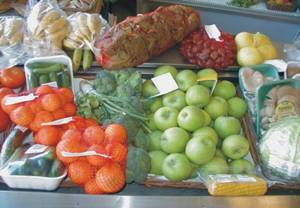Plant foods
Iron and calcium in plant foods are not highly absorbed by the body. Spinach contains a chemical called oxalic acid, which binds with iron and calcium and reduces the absorption of these minerals. To improve iron absorption, spinach should be eaten with vitamin C-rich foods such as orange juice, tomatoes, or citrus fruit.

Fruits
Unlike most fruit, pears are better when picked hard and unripe. They improve in both texture and flavor after they are picked. Pears ripen from the inside out.

Egg
When you are going to beat egg whites, let the eggs sit at room temperature for 30 minutes before using them. The egg whites will beat to a greater volume.

Chervil
Chervil (Anthriscus cereifolium) is an aromatic herb, a member of the parsley family, and indigenous to the areas around the Black and Caspian Seas. It is an essential ingredient of fines herbs, widely used in French cuisine. Chervil has a mild flavor suggestive of anise, and is a great addition to potato salad, egg dishes, soups and tossed salads. It has a mild flavor suggestive of anise. When used in cooked dishes, it should be added near the end of cooking to avoid flavor loss.

Cauliflower
Cauliflower may turn yellow in alkaline water. For whiter cauliflower, add a tablespoon of milk or lemon juice to the water. Do not cook cauliflower in aluminum or iron pot. The chemical compounds in cauliflower will reach. Also if you would like to avoid the very heavy smell of boiling cauliflower, then you could but over the water while boiled, slices of bread (not very fresh) to absorb!

Asparagus
Asparagus are generally available from mid-February through June, with peak season from April to June. When you are buying asparagus, look for closed, compact tips, smooth, round spears and a fresh
appearance. Most of the spear should be a rich green color, and should be tender as far down as the green color extends.
AVOID: Tips that are opened and spread out, moldy or decayed, and spears that are ribbed. Also avoid sandy asparagus, because it is hard to clean.

Ginger
Ginger is available year-round. When selecting ginger root, choose robust firm roots with a spicy fragrance and smooth skin. Gingerroot should not be cracked or withered. It can be stored tightly wrapped in a paper towel or plastic wrap (or put into a plastic bag) in the refrigerator for 2–3 weeks and like galangal, gingerroot can also be placed in a jar of sherry and refrigerated for 3 months.

Potatoes
Potatoes exposed to bright light develop green patches. This green skin contains the toxin ‘solanine’ which can cause cramps, headache, diarrhea, and fever. The solution is simple. Don’t eat the green skin simply remove it the solanine is only present in the green skin and any discoloration underneath it the rest of the potato is completely safe to eat.
Remember always keep potatoes in dark place, room temperature otherwise potato’s skin will become green, and withered!

Beer, wine
Most people included professionals believe that, when using beer, wine or other alcoholic beverages in recipes, a lot of alcohol is left after cooking.
Here are the facts.
Alcohol remaining after preparation:
100% Immediate consumption
70% Overnight storage
85% Boiling liquid, remove from heat
75% flamed
Alcohol remaining: baked or simmered:
40% 15 min.
35% 30 min.
25% 1 hour
20% 1.5 hours
10% 2 hours

Cornstarch
Cornstarch has about twice the thickening power of flour. However, if the liquid is acid, such as citrus juice or apple juice, its thickening power is cut in half. When using with a sauce containing sugar, be sure to add when the sauce is very hot (80 degrees) or the thickening power will be decreased.



